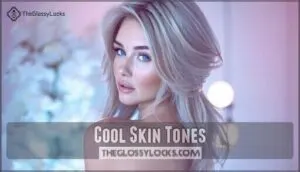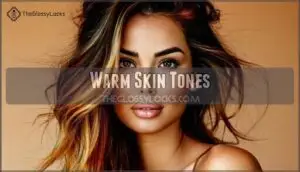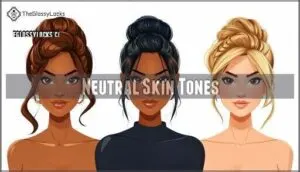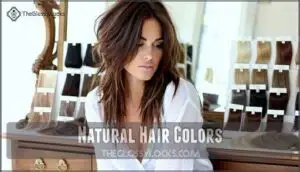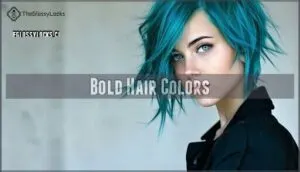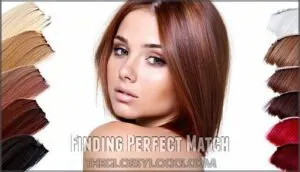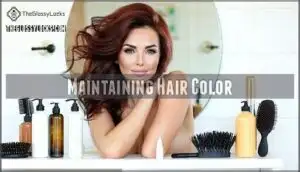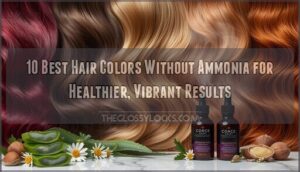This site is supported by our readers. We may earn a commission, at no cost to you, if you purchase through links.
 Finding the right hair color to match complexion isn’t rocket science, but it does require knowing your skin’s undertones.
Finding the right hair color to match complexion isn’t rocket science, but it does require knowing your skin’s undertones.
Cool undertones pair beautifully with ashy browns, platinum blondes, and blue-based blacks. Warm undertones shine with golden blondes, copper reds, and chocolate browns.
Neutral undertones? You’ve hit the jackpot—almost any shade works!
The key is matching your hair’s temperature to your skin’s natural palette. Think of it like choosing the perfect lipstick—when it harmonizes with your complexion, you’ll glow effortlessly.
The magic happens when you understand which specific shades within each color family will make your features pop.
Table Of Contents
- Key Takeaways
- Choosing Hair Color
- Skin Tone Analysis
- Hair Color Options
- Finding Perfect Match
- Maintaining Hair Color
- Frequently Asked Questions (FAQs)
- How do I know what hair color matches my skin tone?
- What color hair makes your face look younger?
- What color best matches my skin tone?
- How often should I change my hair color?
- Can hair color damage different skin types?
- Does hair color fade differently on various complexions?
- Which hair colors work best with acne?
- How does age affect hair color choices?
- Conclusion
Key Takeaways
- Identify your skin’s undertones first – You’ll know if you’re cool (pink/blue undertones), warm (golden/peachy undertones), or neutral by checking which jewelry flatters you most and how your veins appear
- Match hair temperature to skin temperature – Cool undertones work best with ash blondes and blue-based blacks, while warm undertones shine with golden blondes and copper reds
- Consider your lifestyle and maintenance commitment – Bold colors require frequent touch-ups every 4-6 weeks, while natural shades closer to your original color need less upkeep
- Test before you commit – Use online tools or consult a professional stylist to preview how different shades will look with your specific complexion before making the change
Choosing Hair Color
Choosing the right hair color can completely transform your look, but it’s not just about picking your favorite shade.
Your skin tone is the secret ingredient that determines which colors will make you glow and which ones might wash you out completely, making it a crucial factor in selecting a hair color that complements your overall appearance, and potentially making you glow.
Your skin’s undertones are the ultimate cheat code for finding hair colors that make you absolutely radiant.
Skin Tone Considerations
Why does your hair color clash with your complexion? Understanding skin tone is the foundation of choosing flattering hair color.
Your undertones – cool, warm, or neutral – create the roadmap for Color Harmony that enhances your natural beauty.
- Cool undertones pair beautifully with ashy blondes and rich brunettes
- Warm undertones shine with golden highlights and copper shades
- Neutral undertones offer flexibility across the hair color spectrum
- Seasonal Changes affect how colors appear against your complexion matching needs
Personal Preferences
Why settle for "just okay" when your hair color can make you feel absolutely radiant? Your personal style dreams matter most in this journey.
Consider your desired look—whether you’re craving dramatic transformation or subtle enhancement. Think about lifestyle factors like maintenance time and professional requirements.
Age considerations play a role too, as certain shades can refresh your appearance beautifully. Cultural norms might influence your choices, but remember: the best hair color guide is your own confidence boost and what makes your complexion glow.
To find the most flattering shade, start by analyzing your skin undertones to complement your complexion.
Hair Color Trends
Beyond personal taste, today’s hair color trends offer exciting ways to complement your complexion.
Seasonal colors like rich espresso dominate fall, while sun-kissed balayage peaks in summer.
Ombre variations and color melting create seamless shifts that flatter most skin tones.
Pastel hues gained popularity among Gen Z clients, while rooting trends provide low-maintenance options.
These trending techniques in your hair color analysis help you find flattering shades.
Skin Tone Analysis
Understanding your skin tone is the first step to finding hair colors that make you look radiant instead of washed out.
You’ll learn to identify whether you have cool, warm, or neutral undertones so you can choose shades that complement your natural complexion perfectly, which will help you look radiant.
Cool Skin Tones
When identifying cool skin tones, look for pink, red, or blue undertones beneath your skin’s surface. Your veins likely appear blue or purple, and you might flush easily rather than tan.
Cool undertones pair beautifully with specific hair color analysis choices.
- Best colors: Ash blonde, platinum, cool browns, and blue-black create stunning contrast
- Celebrity examples: Think Emma Stone’s silvery blonde or Anne Hathaway’s rich brunette
- Makeup pairing: Cool-toned hair color for me works perfectly with pink-based foundations and berry lipsticks
These flattering hair color choices enhance your complexion naturally while offering excellent color longevity. For a bolder choice, consider how sapphire blue hair can create a fashionable statement.
Warm Skin Tones
Golden skin with peachy undertones deserves hair color ideas that enhance your natural warmth.
Caramel hues, golden highlights, and warm brunettes create perfect harmony with your complexion.
Copper reds bring out your glow beautifully.
When choosing flattering hair color, stick with honey and amber tones while avoiding ash shades that clash with warm skin tones.
Neutral Skin Tones
Neutral skin tones are like chameleons – you can pull off both warm and cool hair colors beautifully.
With balanced undertones, you’ve got the best of both worlds.
Think Jennifer Aniston’s versatile looks or Zendaya’s stunning color transformations.
Your neutral undertones create perfect color balance, making complementary colors like mushroom brown, soft black, or honey blonde work wonderfully.
Seasonal shades? You’re covered year-round with personalized hair color options that celebrity inspiration proves possible.
Hair Color Options
Once you’ve determined your skin tone, it’s time to explore the exciting world of hair color possibilities that’ll make your complexion absolutely glow.
From subtle natural shades to eye-catching bold hues and dimension-adding highlights, there’s a perfect color match waiting to transform your look, with exciting possibilities.
Natural Hair Colors
Natural hair colors offer timeless beauty that complements your features perfectly.
Brunette shades work wonderfully for neutral skin tones, while blonde varieties can brighten your complexion naturally.
Redhead tones add warmth and character to your look.
Consider gray blending for mature hair or root coverage for maintenance.
A personalized hair color consultation helps determine which natural shade enhances your unique coloring best, providing a way to achieve natural shade.
Bold Hair Colors
When you’re ready to make a statement, vivid color trends like electric blues and cotton candy pinks can transform your look completely.
Fantasy hair shades require careful consideration of your color season—cool complexions rock jewel tones while warm skin glows with fiery reds.
Bold color maintenance demands dedication, but creative color techniques make alternative color palettes achievable for everyone, allowing you to incorporate vivid color trends and fantasy hair shades into your look.
Highlighting Techniques
Various highlighting techniques can transform your look when matched to your complexion.
Balayage vs. ombre offers different sun-kissed effects, while strategic foil placement creates precise contrast.
Babylights technique adds subtle dimension, and color melting blends tones seamlessly.
Lowlighting effects add depth to bright hair.
Professional hair color services guarantee proper hair toning for stunning results.
Many stylists recommend using specialized balayage products for superior results with balayage and other techniques like babylights.
Finding Perfect Match
You don’t have to guess what hair color will work best for you – there are smart ways to find your perfect match.
Whether you consult with a professional stylist or use online tools, you’ll discover which shades complement your unique complexion beautifully.
Consulting a Stylist
Professional stylists bring expertise evaluation and can read your hair color chart better than you can.
Trust your stylist’s trained eye – they see what works before you do.
When you’re sitting in that salon environment, don’t hesitate with stylist communication – share photos, discuss your lifestyle, and ask about service expectations.
A good hair stylist will explain pricing transparency upfront and guide you through hair coloring options that’ll actually work with your matching hair goals and maintenance routine.
A key first step is scheduling a consultation, which helps in achieving your desired hair goals.
Online Hair Color Tools
Online hair color tools offer a game-changing way to preview your perfect shade before committing.
These AR technology platforms use shade matching algorithms to analyze your photo uploads, providing virtual consultations with impressive tool accuracy.
Popular apps feature extensive hair color charts and virtual hair color options, from natural tones to bold statements.
While matching hair digitally helps narrow choices, remember these hair coloring previews work best alongside professional guidance.
For superior results, consider using a hair extension color chart to guarantee a seamless match.
Maintaining Hair Color
Once you’ve achieved that perfect hair color match, you’ll want to keep it looking fresh and vibrant with the right maintenance routine.
Your new shade needs proper care to stay true to color and complement your complexion for weeks to come, which is crucial for maintaining the perfect hair color match.
Hair Care Routine
Once you’ve found your perfect shade, maintaining that stunning color becomes your new best friend.
Your hair care routine directly impacts how long your color stays vibrant and healthy-looking.
Here’s your game plan for color-loving hair:
- Shampoo Frequency – Wash 2-3 times weekly with sulfate-free formulas to prevent color fade
- Conditioner Types – Use color-safe conditioners after every wash for moisture and protection
- Heat Protection – Apply thermal protectant before styling to shield strands from damage
Regular hair masks boost scalp health while keeping your hair maintenance routine simple yet effective.
To help maintain your color, consider using products without sulfates.
Color Protecting Products
Beyond your daily hair care routine, choosing the right hair products becomes your color’s best friend. Color-safe conditioners and sulfate-free shampoos keep your shade vibrant longer, while UV protection shields against fading. Leave-in treatments add extra armor against environmental damage.
Selecting shampoos with coconut oil surfactants can further strengthen hair.
| Product Type | Key Benefit | Usage Frequency |
|---|---|---|
| Sulfate-Free Shampoos | Gentle cleansing without stripping | 2-3 times weekly |
| Color-Safe Conditioners | Moisture + color protection | Every wash |
| Leave-In Treatments | Daily shield against damage | As needed |
Deep conditioning masks once weekly restore moisture that color processing removes, keeping your hair healthy and your color true.
Regular Touch-ups
While color protecting products help maintain your hair’s vibrancy, regular touch-ups keep your look fresh and polished.
Schedule root touch-ups every 4-6 weeks to prevent gray coverage issues and color fading.
Root concealers work great between appointments for quick fixes.
Your scalp health benefits from consistent touch-up frequency too, preventing damage from over-processing when you wait too long, which is why regular root touch-ups are essential for maintaining scalp health.
Frequently Asked Questions (FAQs)
How do I know what hair color matches my skin tone?
Like finding your perfect match, determining your ideal hair color starts by identifying your skin’s undertones.
Hold white paper near your face—if you look better in silver jewelry and cool colors, you’ve got cool undertones.
Warm undertones suit gold jewelry and warm hues better.
What color hair makes your face look younger?
Hair colors closer to your natural shade typically make you look younger.
Lighter tones around your face, like highlights or balayage, create a soft glow that minimizes fine lines and adds youthful radiance.
What color best matches my skin tone?
Picture your reflection glowing with confidence as the perfect shade frames your face naturally.
Your undertones hold the key—warm skin loves golden browns and honey highlights, while cool undertones shine with ashy blonds and rich chocolates.
How often should I change my hair color?
You don’t need to change your hair color frequently—every 6-8 weeks for root touch-ups or 3-4 months for complete color changes works perfectly for most people’s needs.
Can hair color damage different skin types?
Absolutely, wrong hair color can be your skin’s worst nightmare!
Chemical dyes can irritate sensitive skin types, causing redness, burns, or allergic reactions.
Always patch-test first—your complexion will thank you later, and this simple step can prevent allergic reactions.
Does hair color fade differently on various complexions?
Your skin tone doesn’t change how fast hair color fades, but it definitely affects how noticeable the fading looks.
Warmer complexions hide brassiness better, while cooler tones show fading more dramatically.
Which hair colors work best with acne?
Want clearer skin to shine through?
Cooler hair tones like ash blonde, auburn, or chocolate brown won’t compete with redness, while warm colors can emphasize inflammation and make breakouts more noticeable.
How does age affect hair color choices?
As you age, your skin’s undertones shift and hair naturally loses pigment, making warmer, softer shades more flattering than harsh contrasts that once worked beautifully in your twenties.
Conclusion
Think of your hair color transformation as painting the perfect frame around a masterpiece—your face deserves nothing less than perfection.
Choosing the right hair color to match complexion isn’t just about following trends; it’s about discovering what makes you uniquely radiant.
Whether you’re going for subtle highlights or a dramatic new shade, remember that the best hair color enhances your natural beauty while boosting your confidence.
Trust your instincts, work with professionals when needed, and embrace the gorgeous new you.
- https://maps.google.com/maps/dir/?api=1&destination=Mather+Hair+Design+%26+Cosmetic+Studio,+8222+East+103rd+Street,+Tulsa,+OK+74133&hl=en
- https://mathersalon.direct.salonservicegroup.com/
- https://www.yelp.com/biz/mather-hair-design-and-cosmetic-studio-tulsa
- http://www.tulsapeople.com/Directories/The-A-List/Body/index.php/name/Mather-Hair-Design-and-Cosmetic-Studio

